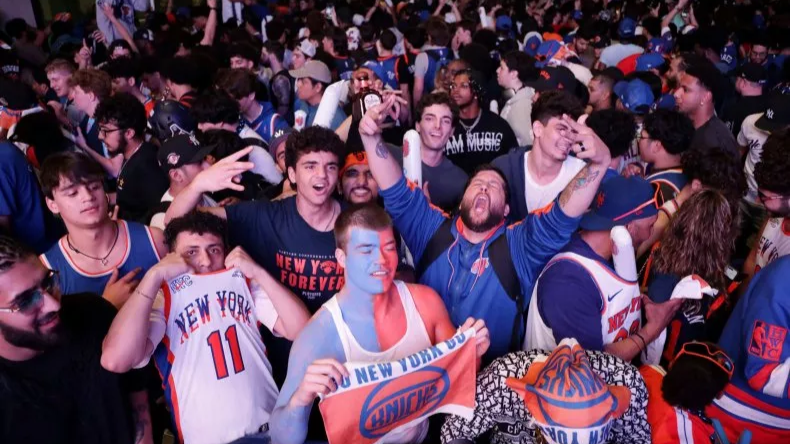The Knicks Playbook: What Every Brand Can Learn About Loyalty That Lasts
PHOTO BY LEONARDO MUNOZ/AFP VIA GETTY IMAGE
There are two kinds of loyalty in marketing: the kind you engineer, and the kind you earn.
One’s built on incentives. The other’s built on identity.
One drives conversion. The other drives conviction.
One disappears when the discount ends. The other sticks around when everything else falls apart.
The second kind? That’s the gold standard. And it’s wearing orange and blue.
Right now, the New York Knicks aren’t just making noise in the playoffs – they’re giving every brand a front-row seat to what hard-earned loyalty actually looks like. It’s not hype. It’s history, belief, and belonging – 25 years in the making.
This is what happens when people stick with you – not because of what you sell, but because of what you stand for.
When they show up year after year, not because the experience is perfect, but because it’s personal.
Not because it’s rational. Because it’s real.
And that’s a brand lesson too many still miss.
Why This Kind of Loyalty Is So Rare—and So Worth It
The last 25 years haven’t exactly been kind to Knicks fans. Fourteen head coaches. Seven basketball execs. Big-name targets who never signed. Draft picks that didn’t deliver. More press conferences than playoff wins. And yet – the Garden still filled up.
Fans didn’t just tolerate the drought. They stuck around. They kept watching. Kept repping the brand. Kept believing. That’s not just loyalty. That’s identity.
And here’s the truth: identity doesn’t come from loyalty programs or branded content. It comes from meaning. From memory. From emotional investment that lives beyond the product. This is where so many brands get it wrong. They think loyalty is something you spark with messaging.
But the Knicks didn’t spark a community. They survived one.
So when the team finally delivered – when grit, hustle, and chemistry replaced chaos – the response wasn’t approval. It was an eruption. Because belief, held long enough, explodes when it’s finally rewarded.
From Loyalty to Advocacy: What the Knicks Got Right
Brands talk about advocacy all the time. But advocacy doesn’t start with a referral link. It starts with people defending you when you’re down.
Knicks fans didn’t return when the wins did. They never left. They wore the logo during losing streaks. They argued for the brand online when there was nothing to gain. They paid premium prices for a team that hadn’t delivered in decades.
That’s not a fan base. That’s a movement. And movements are earned.
So, what should brands take from this?
Real brands don’t make customers. They make believers.
Believers aren’t persuaded – they’re proven right.
And that takes time, tension, and trust.
The Knicks may have unique advantages – location, legacy, and generational pull – but the blueprint they’ve unintentionally laid out?
It’s repeatable. Not in the tactics. In the truth.
The Knicks Didn’t Win With Flash. They Won With Fit.
They stopped selling splash. Started investing in substance. They didn’t hire the most headline-worthy coach. They brought in the one who aligned with their values: toughness, defense, discipline. They didn’t chase superstars. They built a team around effort and accountability. They didn’t promise transformation. They showed it.
And that’s the difference.
Brands too often chase what’s visible instead of what’s valuable. They invest in performance before purpose. They build campaigns instead of cultures.
But the brands that endure?
Double down on the fundamentals.
Build internal alignment before they broadcast external stories.
Make sure the product earns the story – not the other way around.
Four Lessons Every Brand Builder Should Internalize
1. Visibility ≠ Value.
Just because people see you doesn’t mean they believe you. The Knicks were always on TV. Belief showed up when performance and promise finally matched.
2. Trust compounds.
Grit. Accountability. Consistency. When brands live their values – especially when no one’s watching – they earn permission to lead.
3. Your story is only as strong as your product.
Flash may grab attention.But if there’s no substance, attention becomes apathy.
4. If you want a community, act like one.
That means showing up when it’s hard. Listening when it’s quiet. Living your values – not just marketing them.
Measuring the Kind of Loyalty You Can’t Buy
“Belief is the real KPI” makes for a good headline. But how do you prove it in the boardroom?
Start here:
Brand equity tracking: Are awareness, trust, and relevance all moving in the same direction?
NPS: Is your audience willing to go to bat for you?
Earned media: What are people saying when they’re not being paid to say it?
Customer Lifetime Value (CLV): Are belief and identity increasing spend and retention?
Social listening: Tone, emotion, and unsolicited mentions say more than likes ever could.
And here’s the kicker – if all of those are trending up while spend holds steady or shrinks?
That’s belief at work.
The Real Takeaway
This playoff run isn’t just about basketball.
It’s about a brand that, after years of under-delivering, finally found alignment.
Not between marketing and product—but between expectation and experience.
And when that happens? People don’t just buy what you sell. They believe in what you stand for.
They advocate. They defend. They come back—not for the discount, but for the meaning.
And that?
That’s brand equity in its purest form.
Go NY. Go NY. Go.

